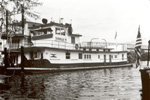Bellaire Bridge

The Bellaire Bridge or Interstate Bridge is a privately owned, closed cantilever truss toll bridge that spans the Ohio River between Benwood, West Virginia (near Wheeling) and Bellaire, Ohio (near Martins Ferry). It provided a link for commuters between southern Ohio border towns and West Virginia steel mills from 1926 to 1991.The overall length of the bridge is 2,770 feet (840 m), including the approach of 850 feet (260 m) on the West Virginia side and 670 feet (200 m) on the Ohio side of the river. The highest point in the bridge is 350 feet (110 m) above the water line.Built in 1926, the bridge is likely the oldest cantilever truss bridge in West Virginia, and is the second oldest vehicular truss bridge over the entire Ohio River. It is currently unused, and missing approach spans on the Ohio side. As of September 2022, the bridge remains standing, with status regarding demolition unknown.
Excerpt from the Wikipedia article Bellaire Bridge (License: CC BY-SA 3.0, Authors, Images).Bellaire Bridge
Bellaire Bridge,
Geographical coordinates (GPS) Address Nearby Places Show on map
Geographical coordinates (GPS)
| Latitude | Longitude |
|---|---|
| N 40.015041666667 ° | E -80.738930555556 ° |
Address
Bellaire Bridge
26031
West Virginia, United States
Open on Google Maps






